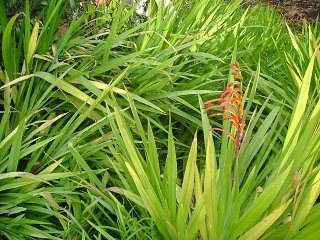 Chasmanthe: Zones 13, 15-24. "Plants are fairly hardy, but late frosts may damage flower buds."
Chasmanthe: Zones 13, 15-24. "Plants are fairly hardy, but late frosts may damage flower buds."This is the gospel from Sunset's Western Garden Book. Obviously, my acres of chasmanthe didn't read the book because even though we had a long spell of record breaking cold here most of last month, the plants are all budded out and beginning to bloom. The hummingbirds will be happy.
I discovered, rather after the fact, that waiting until the chasmanthe leaves turned brown before mowing them down only succeeded in spreading their seeds. Rototilling also spreads the bulbs. Do both and voila! You have acres of Chasmanthe!
 Still and all, they are a pleasant green contrast to typical gray winter weather. Just beware if you have a few, that they can expand their territory faster than you can remember what they are called.
Still and all, they are a pleasant green contrast to typical gray winter weather. Just beware if you have a few, that they can expand their territory faster than you can remember what they are called.The Acacias, Flowering Quince, nut trees, daffys and other narcissus, Helabores, Camellias, Violets, Vinca, Pansies, Violas, Rosemary, ...what am I forgetting? ALL in full splendor right now.
Oh yes, the little Snowdrops. They have been blooming for a month already.
Makes a body want to be outside, digging, weeding, planting, mowing....too bad its still too wet to do so. Not that we don't need the wet! So my friend and I are about to start on our succulent project. We have a stockpile of funky little (and big) planters, baskets, and tins that we are planting baby succulents in. Once they fill in nicely, they will be for sale. At least, that's our plan.

Don't forget that this weekend (Feb. 16-19) is the 10th Annual Great Backyard Bird Count. Go to www.birdsource.org/gbbc for further details. This is open to everyone, there is no need to preregister, and there is no fee required. DO IT! You may be amazed by the number and variety of birds lurking about in your yard. Or in your park, schoolyard, refuge, or cemetary. All ages and all skill levels are welcome. You will report your findings on line and be able to see how your yard and town fit into the big picture.
If you are already feeding birds in your yard, this is a good time to bring in the feeders for a thorough cleaning. Then put them back out filled with quality birdseed and enjoy the show! (don't use that cheap birdseed from the local grocery because it has lots of "filler"; seeds that our birds don't eat. Plus, it contains many weed seeds that are then spread to our surrounding landscape.)
 The goldfinches love Nyjer thistle seed, which isn't really a thistle and which has been treated so that it will not grow when it falls on the ground. Most of the birds that fly UP to feeders prefer black oil sunflower and safflower seeds. The millet is usually eaten by the birds that prefer to dine on the ground.
The goldfinches love Nyjer thistle seed, which isn't really a thistle and which has been treated so that it will not grow when it falls on the ground. Most of the birds that fly UP to feeders prefer black oil sunflower and safflower seeds. The millet is usually eaten by the birds that prefer to dine on the ground.Enjoy!


1 comment:
Oooh... I can't wait to see pictures from your succulent projects! It was nice to see these pictures, too. Spring feels pretty far away from here right now.
Post a Comment